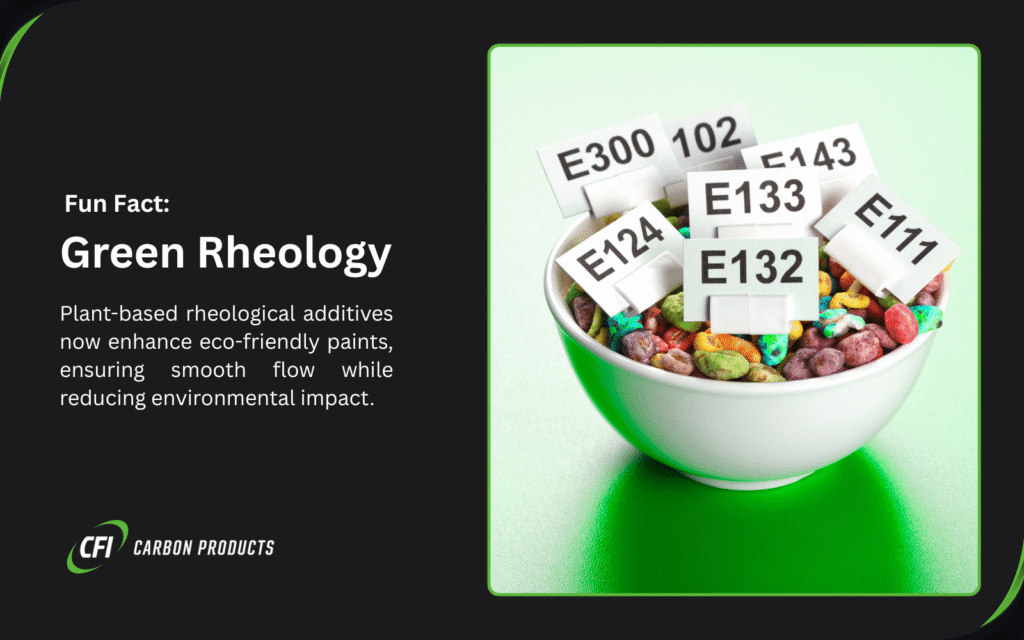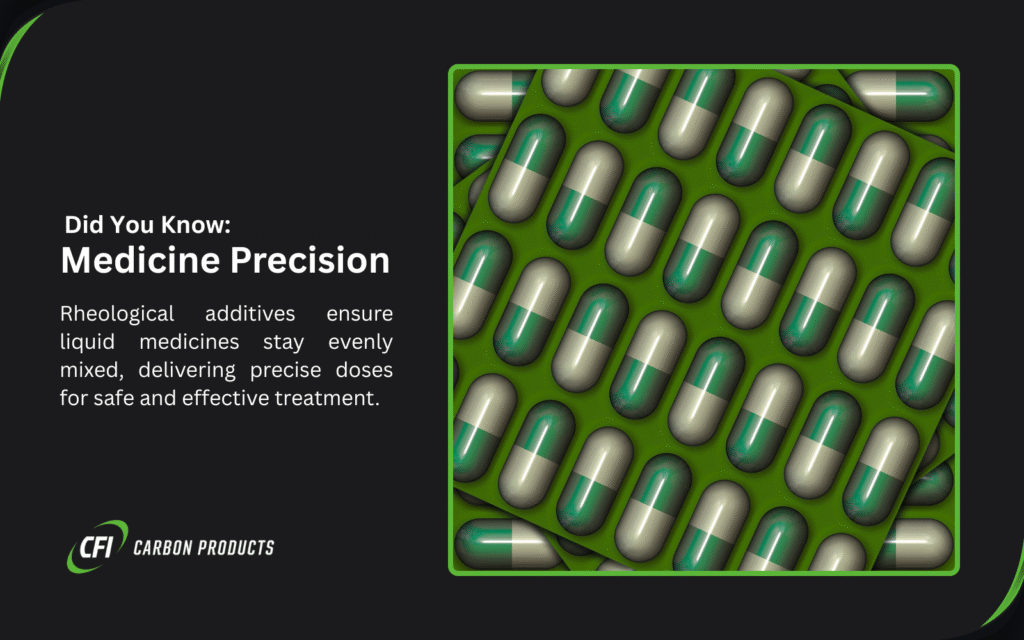Have you ever wondered why your ketchup stays put in the bottle until you give it a shake? Or why doesn’t your paint drip off your brush like water?
The secret lies in something called a rheological additive.
What Exactly is a Rheological Additive?
A rheological additive controls how stuff flows. “Rheology” comes from the Greek word “rheos,” meaning “flow.” These additives are the difference between pancake batter and maple syrup—both liquids, but with very different behaviors when you pour them.
They can:
- Thicken liquids (like turning water into gel)
- Keep ingredients from settling (no more shaking your orange juice)
- Control how something spreads (think paint that doesn’t run down the wall)
- Make products stable on the shelf (so your lotion doesn’t separate into layers)
- Improve how products feel when you use them (that smooth, luxurious feel of premium shampoo)

Types of Rheological Additives
Not all flow controllers are created equal. Each has its quirks and specialties:
Organic Rheological Additives
These are the nature-inspired options, carbon-based and often derived from plants or modified natural materials.
Cellulose Derivatives
Remember making paper-mâché as a kid? That gloopy paste used similar principles to these additives. Derived from plant cell walls, these additives work beautifully in water-based products. Your gluten-free baked goods, low-fat ice cream, and many shampoos rely on these to maintain the right texture.
Castor Oil Derivatives
The versatile overachievers. These work in both water and oil systems. They’re fantastic in lipsticks and balms, giving that perfect glide without melting too quickly. I’ve seen them save countless cosmetic formulations that needed to maintain structure in summer heat.
Polyamides
These create that non-drip magic in oil-based systems. They build a structure that collapses when you apply force (like brushing) but rebuilds quickly when left alone (so no drips down your wall). A classic example of what we call “thixotropy” in the industry—a fancy word for “flows when pushed, stays put when not.”
Inorganic Rheological Additives
The mineral-based team players create structure through tiny particles interacting with each other.
Bentonite Clays
Nature’s own thickener, used since ancient times. These clays swell dramatically in water, creating gel-like networks. They’re in everything from mud masks to drilling fluids.
Fumed Silica
The synthetic miracle worker. These incredibly tiny particles create hydrogen bonds throughout your liquid, building a 3D structure that holds everything in place. They’re particularly good in silicone sealants and adhesives.
Attapulgite Clays
These form needle-like structures that entangle like microscopic pick-up sticks, creating stability without too much thickness. They’re fantastic for keeping pigments suspended in paints and stains. A woodworking friend swears by stains containing these because they don’t need constant stirring.
Associative Thickeners
The modern, sophisticated options that work through molecular interactions:
HEUR (Hydrophobically modified Ethoxylated Urethanes) – They provide excellent leveling in water-based paints, giving that smooth, brush-mark-free finish. Premium interior wall paints often use these to achieve that professional look.
HASE (Hydrophobically modified Alkali Swellable Emulsions) The budget-friendly option that performs impressively well in the right pH conditions. These are the workhorses of many commercial paints and coatings.
The Science Behind How Rheological Additives Work
I promise not to get too technical, but understanding a bit about flow behavior helps explain why the right rheological additive matters so much.
When you stir something, you’re applying what scientists call “shear force.” Different materials respond differently to this force—some get thinner as you stir harder (like ketchup), others maintain their thickness no matter what (like honey).
Key Rheological Behaviors
These are 3 key rheological behaviors:
Thixotropy
This is that magical property where something gets thinner when disturbed but thickens again when left alone. It’s why your house paint flows smoothly off your brush but doesn’t drip down the wall afterward.
Pseudoplasticity
Similar to thixotropy but without the time element—these materials thin immediately when force is applied. Think of shampoo that’s thick in the bottle but flows easily when you squeeze it. Ketchup is another classic example—hard to get out at first, then suddenly flowing too fast! The right rheological additive prevents the “ketchup effect” in products where it’s not wanted.
Yield Value
This is the minimum force needed to get something flowing. It’s like the effort required to push a heavy door open. Too high, and the product is hard to use (like trying to squeeze old toothpaste); too low, and it moves when you don’t want it to (like runny icing that slides off a cake). Getting this just right is often the trickiest part of the formulation.
Mechanisms of Action
How do these additives actually work? Through several clever mechanisms:
- Network Formation: Creating microscopic structures that act like scaffolding in your liquid
- Particle Association: Getting tiny particles to stick together in patterns that control flow
- Molecular Entanglement: Imagine tangled earbuds but on a molecular level—long molecules getting wrapped around each other
- Electrostatic Interaction: Using positive and negative charges to create attraction or repulsion between particles

Applications Across Industries
You wouldn’t believe how many industries rely on rheological additives:
Coatings and Paints
This is where I’ve spent most of my career. In paints, these additives prevent the heavy pigments from sinking to the bottom during storage (no more “stir before use”!), control how the paint applies, and ensure it doesn’t run or sag after application.
For specialized applications like paint additives for cabinets, formulators select additives that create a perfectly smooth, leveled finish that’s durable enough for daily use. I’ve seen cabinet manufacturers switch paint formulations and dramatically reduce their reject rates just by getting the rheology right.
Construction Materials
From concrete to sealants, flow behavior is critical in construction. The wrong consistency can mean disaster.
Personal Care and Cosmetics
This is where consumers notice rheology, even if they don’t know the term. Your shampoo, body wash, and lotions all depend on rheological additives for that perfect consistency.
Too thin, and products feel cheap; too thick, and they won’t dispense properly.
Pharmaceuticals
Liquid medicines need perfect suspension of active ingredients—inconsistent dosing is dangerous. The right rheological additive ensures every spoonful contains exactly the right amount of medicine.
Food Industry
Food scientists call these “texturizers,” but they’re doing the same job. They’re why your salad dressing stays mixed, your yogurt has that spoonable texture, and your ice cream doesn’t immediately melt into a puddle.
Importance in Manufacturing Processes
Getting rheology right affects the final product, and it can make or break your manufacturing process:
Processing Benefits
- Pumping Efficiency: The right flow properties mean products move through pipes and equipment without excessive energy use
- Mixing Uniformity: Ingredients blend completely without dead spots or clumping
- Filling Accuracy: Consistent flow means packaging machines fill each container with exactly the right amount
- Application Precision: Whether it’s automated painting or adhesive application, controlled flow is important
Quality Improvements
- Stability: Products stay mixed without separating or settling
- Consistency: Every batch performs the same way
- Appearance: Better flow control means better visual appeal
- Performance: The right rheology enhances how products work when used
Selecting the Right Rheological Additive
Choosing the right flow modifier is part science, part art, and part experience:
System Compatibility
The additive has to play nicely with everything else in your formula. I’ve seen beautiful formulations ruined by incompatible additives that caused clumping, separation, or even changed the color of products.
For specialized materials like polymer additives, compatibility testing is essential to ensure long-term performance.
Environmental Conditions
Your product needs to perform across a range of temperatures, pH levels, and processing conditions. I remember a car care product that worked perfectly in the lab but failed in real-world testing because the rheology changed dramatically in cold weather.
Specialized resin additives are often formulated to maintain stability across broad temperature ranges.
Application Requirements
How will the end user actually use the product? This drives rheological needs more than anything. For example, adhesive additives need to provide initial grab but also maintain bond strength over time—a delicate balancing act that depends on perfect flow control.
Regulatory Considerations
Different industries have different rules. Food additives face strict scrutiny, as do personal care products. Industrial applications might have environmental regulations to consider.
Rheological Additives in Everyday Products
You encounter flow-controlled products from morning till night:
Morning Routine
- Your toothpaste stays on the brush thanks to carefully designed yield value
- Shower gel that’s thick in the bottle but lathers easily
- Foundation makeup that spreads evenly without running
During the Day
- Hand sanitizer that doesn’t drip through your fingers
- Lunch condiments that pour (or don’t) exactly as expected
- Lip balm that maintains its shape but applies smoothly
Home Maintenance
- Caulk that stays exactly where you put it
- Drain cleaner that clings to pipes instead of rushing past the clog
- Furniture polish that doesn’t run down vertical surfaces

Innovations in Rheological Additive Technology
The field keeps evolving with exciting new developments:
Sustainable Options
The push for greener chemistry has led to plant-based rheological additives that perform as well as synthetic options.
Multifunctional Additives
Why use two additives when one can do both jobs? Modern formulations include rheology modifiers that also provide benefits like UV stabilization or antimicrobial properties. This reduces formula complexity and often improves overall performance.
Precision Engineering
New manufacturing techniques create additives with incredibly specific properties.
Smart Rheology Modifiers
The cutting edge of the field is developing additives that respond to specific triggers—changing their behavior based on temperature, pH, or even exposure to light. Imagine a sunscreen that gets thicker when exposed to UV light, providing extra protection when you need it most!

